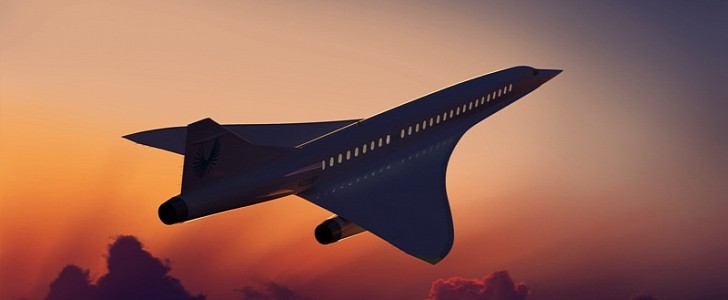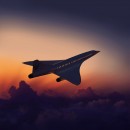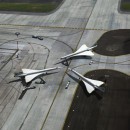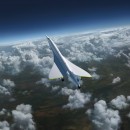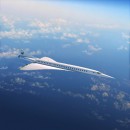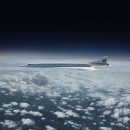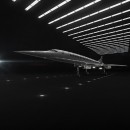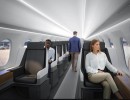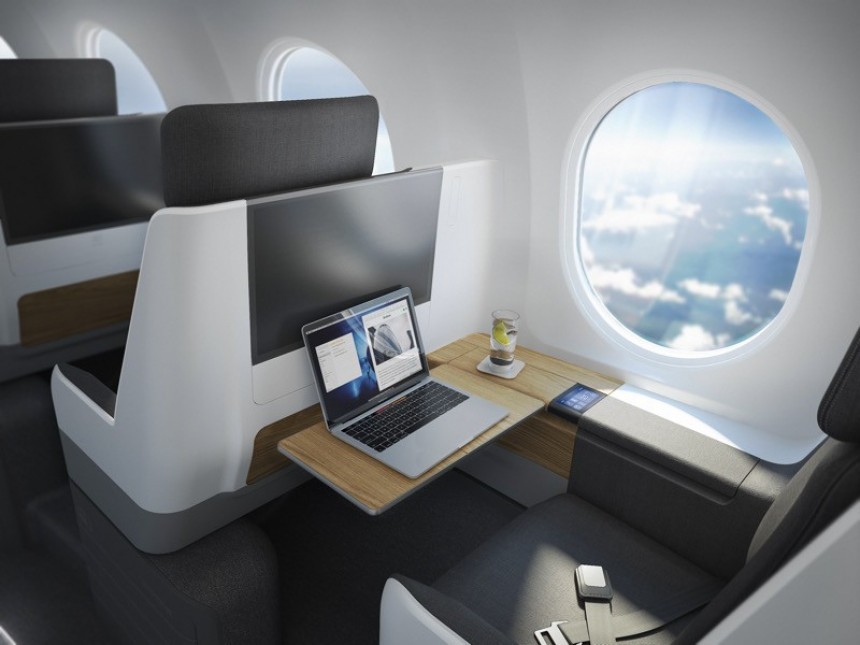The Boom Overture is an under-development supersonic passenger airliner that can reach speeds of up to Mach 2.2, thus becoming the fastest commercial aircraft in the world.
Everything surrounding the mighty Overture is about speed, building upon the priceless legacy that the Concorde left behind for the aviation industry, Boom's founder Blake Scholl claims that the Overture will be at least twice as fast as any other commercial airliner in service. It means that flight times will be drastically reduced, for example, to six hours for a San Francisco to Tokyo trip, or three and a half hours for a New York to London or Madrid to Boston journey.
Spec-wise, the Overture stands really strong on paper. Its claimed range is about 4,250 nautical miles, the equivalent of 4,888 miles (7,866 km). The aircraft spans 199 feet (60.65 m) in length, and its cruising altitude should be of around 60,000 feet (18.29 km).
Its exterior design had been influenced by the famous Concorde, as it comes as a delta wing design. This approach is intended to lower the air drag coefficient during supersonic flight, translating into a low sonic boom.
On July 30, 2020, Boom announced they would work closely with Rolls-Royce on an engine assembly that would complement Boom's Overture airframe. The main reason for choosing Rolls-Royce is that they are the only company with a history of developing commercial supersonic engines, more explicitly the Olympus 593 model that powered the Concorde. Overture's engine design will be similar to the actual turbofan engines found in the commercial aviation industry. Unlike the noisy powerplants of the Concorde, takeoff and landing will not be any louder than any subsonic jet currently in service.
The use of existing technology already proven to be safe and accepted by regulators represents another defining aspect of the Overture. Many of the composite materials, turbofan engines, avionics, flight control systems, and many more components is similar to those already in use in subsonic jet aircrafs today.
The interior cabin will be a place of luxury, serenity, and comfort, the company says. The Overture will be able to seat between 55 and 75 people, along with two pilots and four cabin crew, in an all-business-class interior arrangement. Each seat has a direct view outside and access to the central aisle, access to a high definition smart screen, dining attachments, and areas to store books and use electronic devices.
To date, this supersonic ariplane seems to the one with the highest chances of success. Japan Airlines (JAL) partnered up with Boom as a strategic investor to collaborate in the aircraft design and passenger experience departments. Their agreement will allow JAL to buy 20 Overture aircraft through a pre-order arrangement. Also, last week United AIrlines became the first U.S. customer, placing an order for 15 Overture aircraft.
Not least, Boom Supersonic had been awarded a contract by the U.S. Air Force to create an executive variant of the Overture for top leadership transport application, including an Air Force One replacement. The aircraft will be adapted to satisfy specific FAA airworthiness and production regulations and meet specific requirements for various military use cases. Furthermore, the Overture could become part of the Civil Reserve Air Fleet (CRAF), enabling humanitarian missions to be completed in a far more efficient manner.
With a cost of approximately $200 million per aircraft, Boom has already secured around $6 billion in deals. All these aspects considered, the Overture supersonic airliner is off to a great start in this complex journey. However, its maiden flight remains scheduled sometime around 2030, so there is still a long way to go and always more room for improvement.
Spec-wise, the Overture stands really strong on paper. Its claimed range is about 4,250 nautical miles, the equivalent of 4,888 miles (7,866 km). The aircraft spans 199 feet (60.65 m) in length, and its cruising altitude should be of around 60,000 feet (18.29 km).
Its exterior design had been influenced by the famous Concorde, as it comes as a delta wing design. This approach is intended to lower the air drag coefficient during supersonic flight, translating into a low sonic boom.
The use of existing technology already proven to be safe and accepted by regulators represents another defining aspect of the Overture. Many of the composite materials, turbofan engines, avionics, flight control systems, and many more components is similar to those already in use in subsonic jet aircrafs today.
The interior cabin will be a place of luxury, serenity, and comfort, the company says. The Overture will be able to seat between 55 and 75 people, along with two pilots and four cabin crew, in an all-business-class interior arrangement. Each seat has a direct view outside and access to the central aisle, access to a high definition smart screen, dining attachments, and areas to store books and use electronic devices.
Not least, Boom Supersonic had been awarded a contract by the U.S. Air Force to create an executive variant of the Overture for top leadership transport application, including an Air Force One replacement. The aircraft will be adapted to satisfy specific FAA airworthiness and production regulations and meet specific requirements for various military use cases. Furthermore, the Overture could become part of the Civil Reserve Air Fleet (CRAF), enabling humanitarian missions to be completed in a far more efficient manner.
With a cost of approximately $200 million per aircraft, Boom has already secured around $6 billion in deals. All these aspects considered, the Overture supersonic airliner is off to a great start in this complex journey. However, its maiden flight remains scheduled sometime around 2030, so there is still a long way to go and always more room for improvement.
